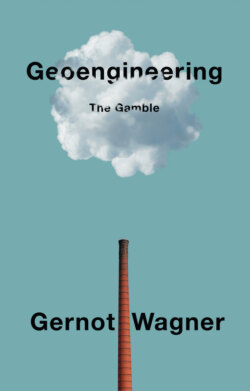Читать книгу Geoengineering - Gernot Wagner - Страница 21
Notes
Оглавление1 1 See Sherwood et al. (2020).
2 2 See Wagner and Weitzman (2015).
3 3 See note 15 on page 11.
4 4 See Pigou (1920, p. 161).
5 5 See Aklin and Mildenberger (2020).
6 6 See Wagner and Weitzman (2012) for the first mention of “free driver,” and Weitzman (2015) for a formalization of the idea.
7 7 See e.g. Schelling (1996); Barrett (2008); and Victor (2008).
8 8 See Zeckhauser (2006) for a standard classification in the investment context. Also see Chapter 2.
9 9 See Stockholm International Peace Research Institute (2018) as well as the discussion in Smith and Wagner (2018). A further 15 countries have military budgets over $3 billion, bringing the total number of countries to 50.
10 10 See McClellan et al. (2010) for the original consulting report, resulting in a subsequent peer-reviewed analysis (McClellan et al., 2012). See the discussion in the introduction of Smith and Wagner (2018) for further studies as well as Lockley, MacMartin, and Hunt (2020) for an updated review.
11 11 See Keith (2013, p. 6).
12 12 Prior to Pemco, Wake Smith was the COO of Atlas Air Worldwide Holdings. He was also President of the training division of Boeing.
13 13 See Smith and Wagner (2018). See Buck and Wagner (2018) for some of the immediate media fallout, discussed further in “Too fast and/or too slow?” in Chapter 3. Smith has since taken things further, calculating “mature” deployment costs (Smith, 2020) and joining forces with aircraft engineers to explore the SAIL aircraft design further (Bingaman et al., 2020).
14 14 Jacobsen et al. (2019) put the global figure at $73 trillion across 143 countries.
15 15 See Barrett’s (2008) “The incredible economics of geoengineering” for an astute early take.
16 16 See, for example, Horton and Reynolds (2016) and also Reynolds and Wagner (2019).
17 17 See note 3 on page 3.
18 18 See Crutzen (2006). See Necheles, Burns, and Keith (2018) for a detailed look at solar geoengineering research funding.
19 19 See U.S. Global Change Research Program (2019).
20 20 See note 10 on page 18.
21 21 See Victor (2008, p. 324) as well as Wagner and Weitzman (2015, chap. 6) for an attempt at just such a screenplay.
22 22 I counseled Jeff Bezos not to “tilt advocacy much too quickly into one direction” by spending even a fraction of his pledge on solar geoengineering research, let alone deployment: “There is similar danger in distorting the overall climate policy and technology landscape with one person’s preferences. Imagine a (crazed) billionaire spending $1 billion on deploying solar geoengineering now” (Wagner, 2020a). The Economist (2020), meanwhile, was more direct, calling for a doubling of current solar geoengineering funding of $20 million annually.
23 23 See Bodansky (2013, p. 548).
24 24 See Reynolds and Wagner (2019) as well as Chapter 6.
25 25 See Roth (1993) for the early history of experimental economics, including a description of the game conducted by Melvin Dresher and Merrill Flood in 1950 that would later be named the “prisoner’s dilemma.” Poundstone (1993) presents this and many more such dilemmas in game theory.
26 26 See, for example, Thomson (1985) and Edmonds (2013).
27 27 See the discussion around table 1 in Fabre and Wagner (2020) for more details.
28 28 As I argue with Adrien Fabre in Fabre and Wagner (2020), while others model total mitigation as the sum of each player’s contribution (Barrett, 2007; Sandler, 2018), this may not just apply to climate negotiations but also to mitigation efforts per se: “If the combination of diverging mitigation efforts ([L1, H2] or [H1, L2]) led to moderate overall mitigation effort M, it might be reasonable to treat M and L the same for purposes of this analysis. That might hold especially if there is a threshold of sorts between M and H. If so, only the outcome H might lead to stabilizing global climates, while both L and M would imply indefinite warming, albeit at different speeds.”
29 29 See Barrett (2007).
30 30 See e.g. Gillingham and Stock (2018).
31 31 See Aklin and Mildenberger (2020).
32 32 See e.g. Kothen (2018) and Nordhaus (2015).
33 33 See e.g. Wagner (2020b).
34 34 See table 2 in Fabre and Wagner (2020) and the discussion around it for further details.
35 35 Table and description taken from Fabre and Wagner (2020), table 3.
36 36 See Fabre and Wagner (2020). The solution is strikingly simple, going back to a subgame-perfect Nash equilibrium in a non-cooperative game (Nash, 1951; Selten, 1965). Adrien Fabre and I are not the first to point to this possibility (Fabre and Wagner, 2020). Others have pointed to the possibility in the context of strategic climate negotiations (Millard-Ball, 2012; Moreno-Cruz, 2015; Urpelainen, 2012). At least one study looking to public opinions also points to the possibility of how mere mention of solar geoengineering might prompt some to want to mitigate more, in this case in the form of buying more carbon offsets (Merk et al., 2016). (See note 28 on page 130 and the discussion around it.)
